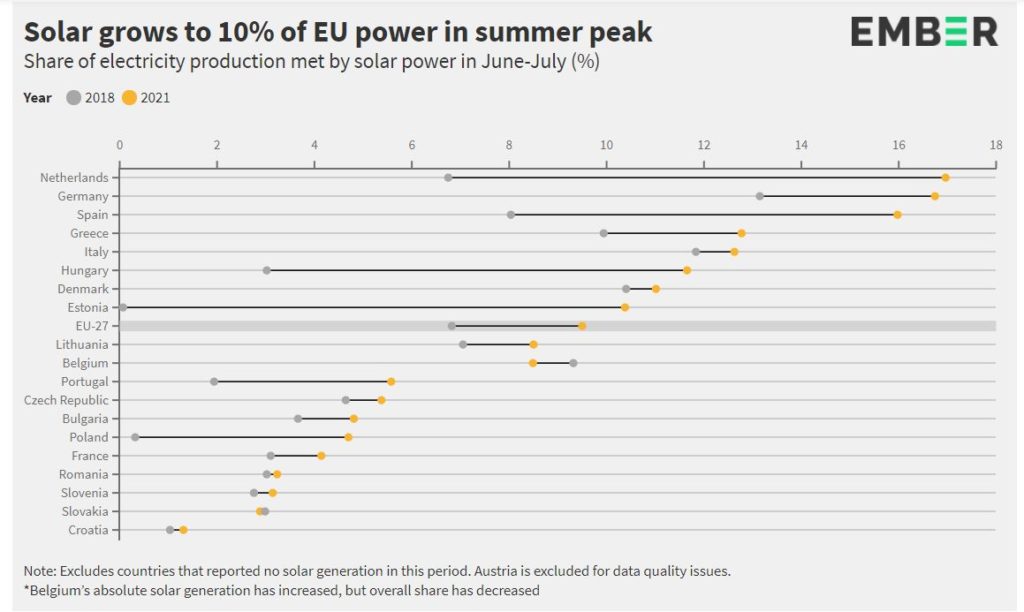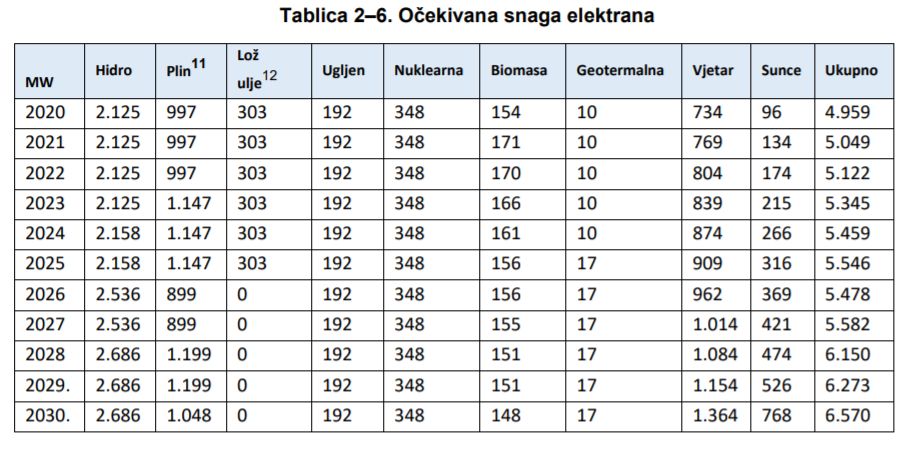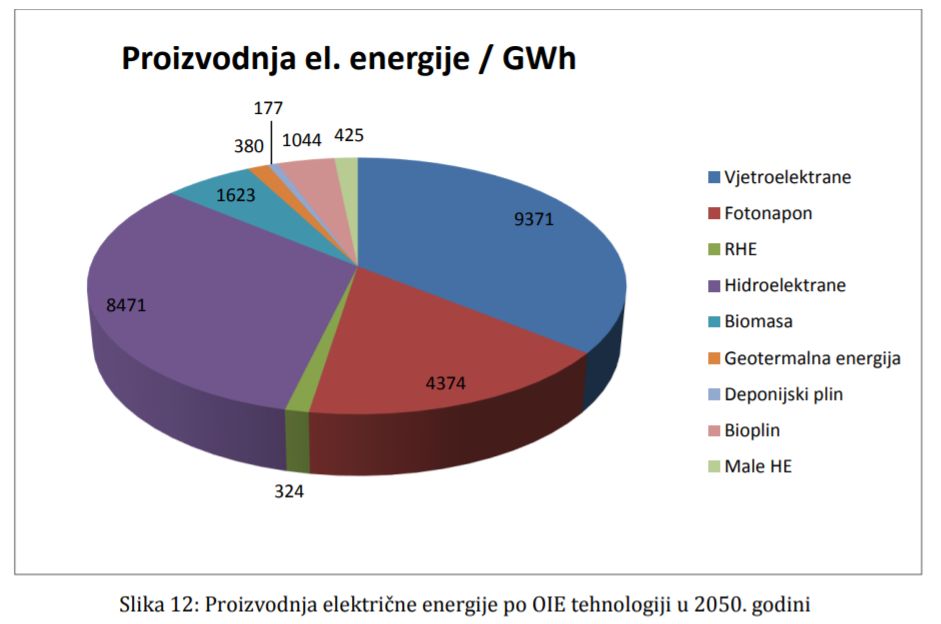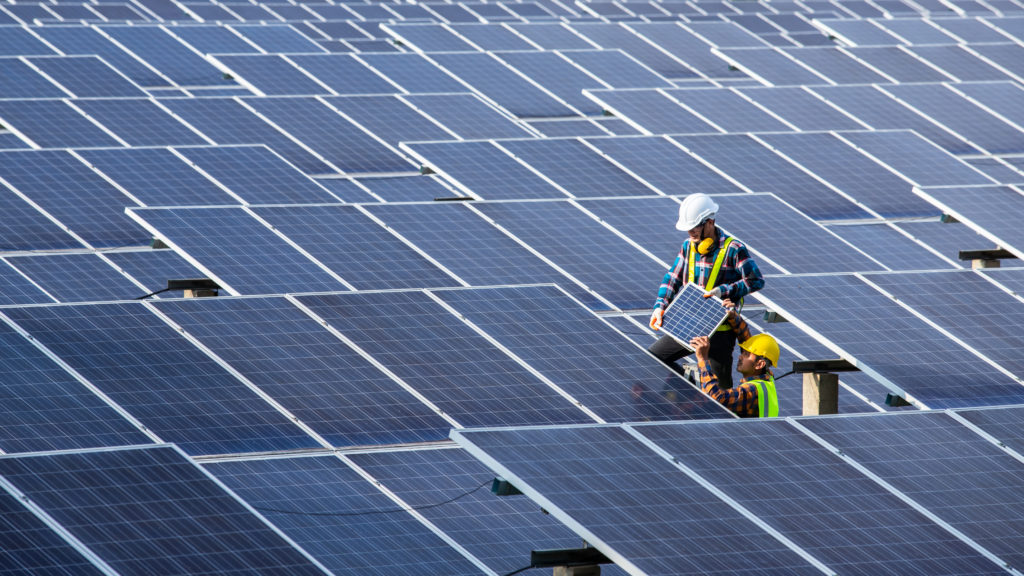Original article (in Croatian) was published on 01/06/2022
Croatia is by far the worst in the EU in terms of electricity production from solar energy, although thanks to its climate, it could be among the best. We investigated what the problem was.
Once upon a time, the sixth factory of photovoltaic modules in the world was opened on the territory of today’s Croatia. In 1987, the area of the former Yugoslavia at that time had 50,000 thermal collectors. Germany at the time had about 17 times fewer – about 3,000, as well as zero solar cell factories. Since then, many things have turned upside down.
The results of Croatia’s solarization are illustrated by comparisons that sound like black humor jokes. The most worn says:
“The fact that the Maribor area in neighboring Slovenia alone has more solar power plants than the whole of Croatia speaks volumes about how far behind we are and how much we need to make up in a short time”. This was stated in the summer of 2020 by Maja Pokrovac, director of the Economic and Interest Association Renewable Energy Sources of Croatia.
In 2021, we managed to “cut” Maribor, but no one dared to take out the champagne. Zoran Tomic from Greenpeace will direct us to a list published on Wikipedia on the growth of photovoltaic drives in the world from 2016 to 2020. Out of 78 countries that are doing better than Croatia, we could choose a few dozen for comparative astonishment. But we will choose only one: Yemen.
A country that has been torn apart by war for years, and images of hungry children of this hell on earth are constantly traveling the world with appeals to stop the humanitarian catastrophe, in those four years has had significantly better results in solarization than Croatia. From 80 MW in 2016, they grew to 253 MW in 2020, while Croatia grew from 56 MW to 85 MW of electricity obtained from solar cells in the same period.
Enfant terrible
Last year, we finished last in the European Union regarding the share of solar in electricity supply in the sunniest months. The sun covered 10 percent of electricity demand in the EU this summer. Croatia, whose solar minimum of 1200 kWh per square meter is higher than the maximum amount of sunlight that illuminates Germany and amounts to 1100 kWh per m2, looked like this on the graph made by Ember Climate:

Unambitious Croatia has long been called enfant terrible by the organization that monitors investing in the direction of the company’s sustainability, Bankwatch. Croatia is not giving up the title even in the period when solar panels are becoming the cheapest way to reach megawatts. And we need them because Croatia is not able to produce as much electricity as it consumes. Depending on the amount of rain and water levels of the rivers that drive the turbines of large hydropower plants built during Yugoslavia, we import between 10 and 30 percent of our annual needs on average.
Today, Croatia produces about 150 GWh of electricity from solar panels. That is why the ambition of the project led by the administration of Zagreb Mayor Tomislav Tomasevic to install solar panels with a total annual production of 50 GWh of electricity by the end of the mandate looks spectacular.
However, the annual electricity consumption in Croatia is more than 120 times higher. According to the report of the Energy in Croatia of the Ministry of Economy, in 2019, it reached 19 thousand GWh.
The question of why Croatia, with so much sun, relies so little on it, is expected to lead to various answers and excuses. Not every one of our interlocutors will agree on the weight of each item, but two dominate: a complete lack of ambition and a series of bad decisions at the top.
Legal restrictions
Until the amendments to the Law on Renewable Energy Sources and High-Efficiency Cogeneration (ZOIEVUK) in 2018, “there was practically no way” to connect to the system as a small electricity producer, recalls Neven Duic, a professor at the Faculty of Mechanical Engineering and Naval Architecture in Zagreb.
“They could only get a permit through the production system at an incentive price, through the fastest finger system. Only with the amendments to the Law (ZOIEVUK) from 2018, a new system for own consumption was opened, and the solar sector is gradually being opened there”, states Duic. According to him, it is optimistic that in 2019 there were only about seventy roofs with solar panels in Croatia. In 2020, their number increased to 780, and on January 1, 2021, they entered with 851 roofs with solar self-sufficiency.
“It is gradually growing, but it is still small amounts”, Duic said. The new law also made it possible for people to unite, which was not possible before. It was possible for someone to put panels on the roof, but that would remain the solar of one owner. It is now possible to jointly own several residential buildings.
Professor Ljubomir Majdandzic, the former head of the Environmental Protection Fund and the man who installed the first solar power plant on his own house, still sees the same law as a serious obstacle. Hairdressing salons, family farms, smaller industries – everyone should be able to submit to the network and take over from it, but the current law does not allow it, Majdandzic tells us.
“Everyone must be able to have such a thing, to be able to transfer and take energy from the network. Then the solarization of the Republic of Croatia will really happen and then it will be possible to say that Croatia has progressed and that it is no longer at the bottom of the European scale”, Majdandzic points out.
The ministry promises further repairs to the law
The Ministry of Economy responds to this criticism by claiming that Croatia through the regulatory framework “significantly encouraged the production of electricity from solar energy, which is evident from the Energy Development Strategy of the Republic of Croatia, the Integrated National Energy and Climate Plan for the Republic of Croatia and the Electricity Market Act”
According to the new ZOIEVUK from 2021, electricity suppliers are obliged to take over surplus electricity from end customers with their own electricity production or users of self-sufficiency plants that cumulatively meet the requirements prescribed by law.
“An important difference in relation to the previous law is that they did not cover apartment buildings. At the national level, the Energy Efficiency Fund has been preparing and conducting public tenders since 2019 to encourage the users of self-sufficiency plants, and this will continue to work in the future”, the Ministry of Economy states in its response.
Croatia, they continue, has been encouraging electricity production from renewable sources since 2007. To date, the system has been changed and adjusted in accordance with European directives and guidelines, the costs of realization of certain types of plants, etc.
“In that period, significantly more than 1000 MW of new production plants that produce energy from renewable sources were built and connected to the electricity network”, they state.
The EC has approved incentives that exceed our 2030 plan
The Ministry of the Economy states that the European Commission has approved the State Aid Program for Croatia to stimulate the production of electricity from OIEVUK with a market premium of 2021-2023. Of the total approved quota of 2010 MW approved to encourage the production of electricity from renewable sources, as much as 865 MW refers to the quota for solar power plants (which amounts to about 7.5 thousand GWh annually).
This figure gives reason for optimism, but again it will be reduced to realization. Namely, the mentioned quota far exceeds the ambitions of the Republic of Croatia, which were included in the Integrated National Energy and Climate Plan for the Republic of Croatia from 2021 to 2030. The plan counts on increasing the power of solar power plants to only 768 MW by the end of the decade (which is about 6.7 thousand GWh annually).

By comparison, the eternally crisis-ridden Greece installed 913 megawatts of solar in just one year, i.e., during the COVID crisis in 2020.
Finally, they state that the Croatian Energy Market Operator (HROTE) has published a public call for bids to encourage the production of electricity from renewable sources and high-efficiency cogeneration with a market premium. It shows that “in the public tender, the quota for stimulating electricity from solar power plants will amount to 300,000.00 kW”, or 300 MW.
Solars do not produce enough electricity?
We also asked the Ministry of the Economy how a Mediterranean country like the Republic of Croatia ended up at the bottom of the EU member states in terms of the share of electricity needs covered by the sun in summer. It should also be taken into account the fact, they answer, that “production per unit of installed power is the lowest in solar power plants”.
“Therefore, despite the fact that the total installed capacity of solar power plants significantly exceeds some other types of production plants that produce electricity from renewable sources, the amount of solar energy is lower precisely for the aforementioned reason. It is also important to note that when comparing the share of individual energy sources in production or consumption, it should be taken into account that the Republic of Croatia produces energy from significantly more sources than in some other EU member states”, they write.
How to speed up HEP?
The most frequently mentioned culprit after the Government is Hrvatska elektroprivreda (HEP). Professor Duic reminds that two years ago, it took two days to install the solar system on the roof, and it took 363 days to put everything together and solve the paperwork. Now, the wait for the network connection is shorter, but it still takes too long.
Matej Stipeljkovic agrees with this statement, who started a company for the installation of solar power plants in the middle of a pandemic.
“Everything ultimately depends on the person who gets the document, there are certain deadlines and rules, but they are not always respected. HEP formally has a positive atmosphere towards photovoltaics, but in practice, it is sometimes different”, states Stipeljkovic.
HEP reports that the final phase of the operational adjustment of HEP – Distribution System Operator (HEP ODS) to the new unified system (SAP) is underway. This information system will replace several old ones. In addition to getting used to the operational staff, intensive work is being done to eliminate the observed errors. They also work on the accelerated resolution of unresolved cases, primarily related to connecting to the network and changing the status of network users (customers to customers with their production), as in the case of installing photovoltaic systems in family homes. They are trying to solve all this as soon as possible.
However, it seems that the Croatian Energy Regulatory Agency (HERA) believes that HEP should be further “pushed”. They suggest stricter penalties for HEP in case of delays in the network connection (Energetika.net).
By the end of October 2021, HEP ODS had connected 463 photovoltaic power plants (FNE). Until then, 3,497 photovoltaic power plants were connected to the electricity network (at the end of 2018 – 1,701, in 2019 – 1,961, in 2020 – 2,882). They expect the positive trend to continue in the next period.
The purchase price is too low
Matej Stipeljkovic believes that the billing of electricity does not stimulate mass solarization.
“Colleagues from Slovenia inform me that all the energy produced is sold to the distributor on a one-for-one basis – if I have produced and delivered it, it costs the same as the one I will spend when I do not produce it. In our country, the case is different – if you spent it – one for one, and if you sell it to the gird, then it is cheaper”, states Stipeljkovic. According to him, the surplus delivered to the grid in the summer should be equated with the production of energy that the producer will need in the months when there is less sun.
HEP only answers that the cost is legal, known to the buyers-producers and that they agree to it. Electricity delivered to end customers is charged according to the price list published on the official website, while redemption prices are formed in accordance with Article 44 of the ZOIEiVUK.
“More precisely, the amount of electricity produced that is less than or equal to the total electricity consumed in the billing period is valued as the amount of electricity supplied, while the purchase price for surplus production in terms of ZOIEiVUK is defined in accordance with the provisions of the Act”, they said. And the law prescribes that the supplier is obliged to take over the surplus at the price of 0.8 x the price of electricity in a particular tariff.
“End customers who have opted for this model are generally well informed about solar systems, billing, rights and obligations, so complaints about billing are very rare”, they say.
Excessive incentives and lack of staff?
Stipeljkovic also believes that the incentives are too high. It turns out that installing solar is not really worth it, although that is not true.
“In that way, the reputation of the whole project is ruined. My house is in Rijeka Dubrovacka. We have an 80 percent subsidy because the aggressors were in our street. But the war was 30 years ago. Almost the entire county is at 80 percent and no one wants to get into that business without a subsidy. And then, when the competition comes, half of them do not pass, so they are waiting for the next year”, recounts Stipeljkovic. According to him, solarization would be much faster with smaller but more numerous subsidies, for example, 20 percent.
Some of our interlocutors also see the lack of skilled workers who would do the job of installing solar panels on roofs as an obstacle to faster installation. But Stipeljkovic, who is doing that, does not seem to be short of staff.
“Many universities have courses, and we who design and construct power plants can do three times as much. There are intentions at some colleges to introduce specialized subjects. I welcome and support such reflections and decisions. We, who are already in that business, would need additional education”, states Stipeljkovic, but then he brings us back to HEP.
Hrvatska elektroprivreda must be more functional because HEP is necessary for two of the three steps, and it takes too long to wait for their two field trips and registration in the application.
Hydropower plants are ideal for balancing the grid
According to a 2015 study conducted by the Green Energy Cooperative, commissioned by Greenpeace, Croatia should invest 13 billion euros in new production facilities by 2050, but during the transition, energy imports would be significantly reduced, saving 4 to 5 billion euros per year.
Solar should play an important role here. In addition to squeezing out the share that thermal power plants had, they would have to have a production capacity almost six times greater than that outlined by the Government in its plans until 2030.

Croatia can become 100 percent renewable, Professor Duic assures us, perhaps until 2030, only if our strategy is not so conservative. According to him, the key problem is heating and moving gas boilers and electrification of transport.
“But as far as electricity itself is concerned, hydropower is great for balancing wind and solar and we can do it without a problem”, he points out. Namely, hydroelectric power plants have the least power in summer, when they have the least water.
The step made by Greece, Tomic emphasizes, speaks best of how unambitious we are.
“I believe we will hear that Greece has had such results due to energy disconnection and indentation. But then why do the Czech Republic, Hungary, Slovakia and Slovenia have ten times more solar panels than us?” – he asks. Tomic believes that it is high time for Croatia to recognize and get involved in setting up micro solar.
“Instead, we constantly hear about the high share of renewable energy sources, and no one should say that this share is almost entirely made up of former Yugoslav hydroelectric power plants and wood heating. Solariums and wind are what we want to talk about. And there is the problematic political will, it is the alpha and omega of everything. In our country, large energy projects exist only in the form of LNG, gas and oil fields. Concessions are issued on land, and the Green Paper also shows that offshore gas and oil production is planned. These are all wrong directions”, states the director of Greenpeace in Croatia.
Heat islands, aesthetics and lobbying
We also asked Duic how he views the criticism that solar panels lead to the warming of the microclimate. That solar panels can increase the local temperature is true for some roofs, but in principle, he points out, the opposite effect occurs.
“The panel protects the roof from direct insolation and cools the house below. In addition, heat islands are solved by trees, and the roof has less impact”, says Duic.
He also states that, both in Dalmatia and in Zagreb, there was a negative perception of the panel for too long due to aesthetic reasons. And that was another reason for hesitation. But, according to him, perhaps one of the biggest problems of small solar companies is that they do not have their own lobbyists. Aside from environmental organizations that proverbially no one listens to, many small producers don’t have that negotiating eros that a prominent wind farm lobbyist can have.
“We pointed out the advantages of solar panels, not only to state structures but also to some entrepreneurs in tourism, but there was no response. We haven’t had 50 MW for years”, confirms Tomic from Greenpeace. He reminds that Croatia is very vulnerable to climate change, but that does not lead to a change in consciousness.
“The topic of climate appears vaguely because we are poor little ones, and it does not concern us. But then floods, fires or events like the sinking of the platform Ivana D come to us. That same platform contributed to climate change”, concludes Tomic.
Apathy is wider than Croatia
Apathy and the slow abandonment of fossil fuels, unfortunately, is not localized in Croatia. An environmental activist, 50-year-old photographer Wynn Bruce, came in front of the Supreme Court building in Washington on Earth Day and set himself on fire. His body burned for a whole minute before he was extinguished. He didn’t drop a voice.
Unlike attorney David Buckel, who announced his “premature death caused by fossil fuels” to the media four years earlier and then poured gasoline and set himself on fire in Brooklyn, no manifesto or direct message from Bruce has been found so far. But from the posts that Bruce left on social media, it is difficult to conclude that there was another motive: self-immolation is a protest against climate change.
The news of Bruce’s self-immolation on Earth Day went pretty unnoticed. It was reported by one Croatian media outlet three days after the self-immolation took place.
People in those days were mostly amused by Elon Musk’s announcements that he would buy Twitter for $ 44 billion. The richest country in the world, the United States, decided to allocate only one billion more for its climate budget for 2023 than Musk for Twitter, or 45 billion dollars. For the war in Ukraine, which led to one of the world’s biggest energy shocks in decades, the United States set aside as much as eight billion – a total of 53 billion dollars.
Europe has said that it will accelerate the energy transition to reduce dependence on Russian gas. However, it found itself in a bizarre situation to complain to India about the import of fossil fuels from aggressor Russia and to receive an answer from India: but we import in a month as much as you import in one afternoon.
Meanwhile, the climate system remains indifferent to political performances regardless of the topic and focuses only on greenhouse gas emissions.

